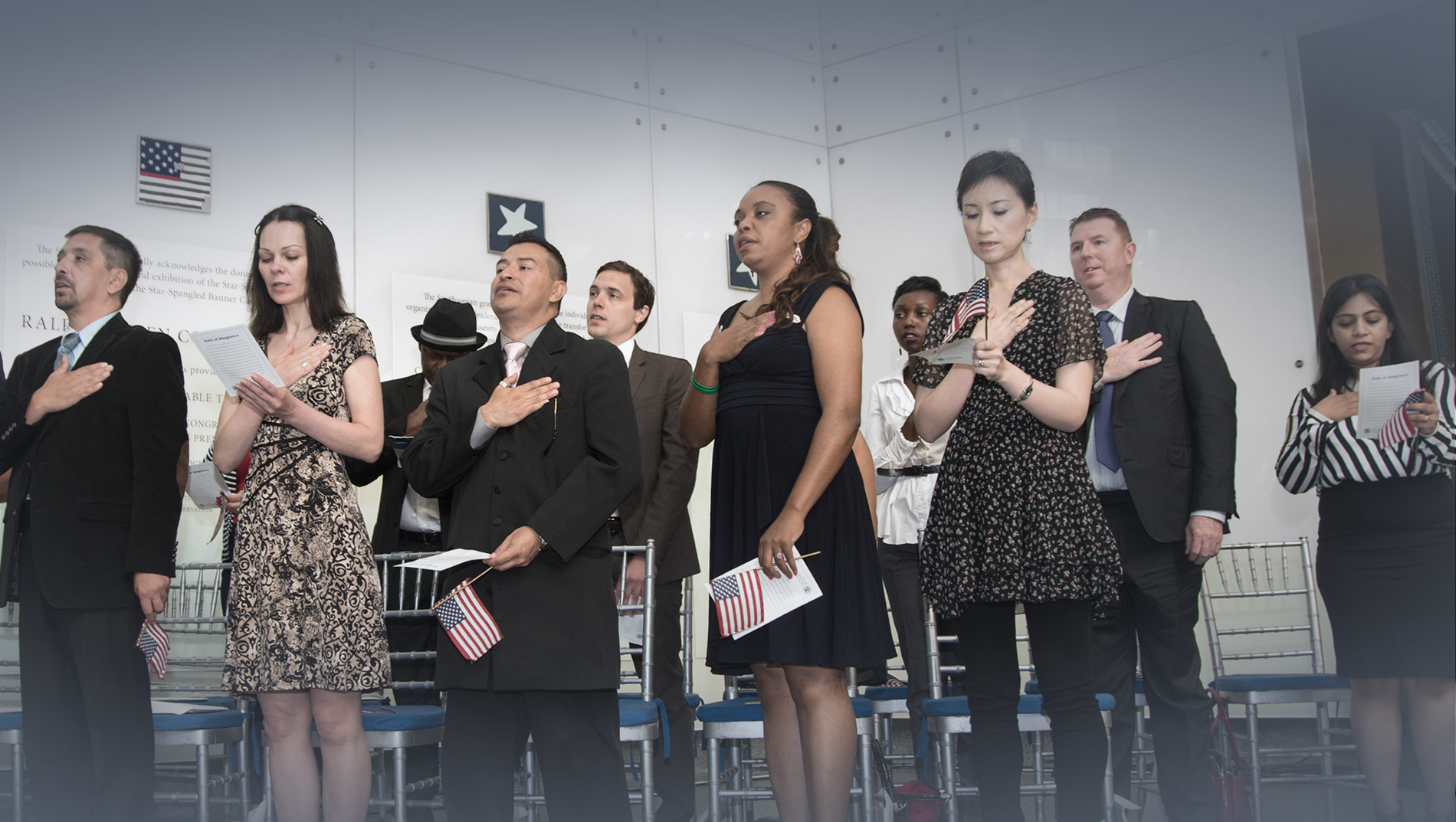Immigration 101
How the United States Immigration System Works
- How the Immigration System Works
- June 24, 2024
U.S. immigration law is very complex, and there is much confusion as to how it works. This fact sheet provides basic information…
Read More
Birthright Citizenship in the United States
- Birthright Citizenship
- October 16, 2024
This fact sheet explains birthright citizenship, the Fourteenth Amendment, and its interpretations. Who is…
Read More
Asylum in the United States
- Asylum
- August 27, 2014
Asylum seekers must navigate a difficult and complex process that can involve multiple government…
Read More
Reforming America’s Immigration Laws: A Woman’s Struggle
While immigrant communities across the nation endure the long wait for immigration reform, there are roughly 19 million immigrant women and girls currently in the U.S. Immigrant women, particularly the undocumented, are often more vulnerable than their male counterparts, lack the same economic opportunities, and experience exploitation while crossing the border, while working and even in their own homes. In short, immigrant women have become the silent victims of a broken immigration system. In this IPC report, immigration attorney Kavitha Sreeharsha lays out the economic and social disparities, legal barriers to current immigration law and the many dangers hard-working immigrant women are forced to endure. The report also explores how women are distinctly harmed by heightened enforcement of immigration laws. Abusers, traffickers, and exploitative employers keep immigrant women from seeking local law-enforcement protection by convincing them that police officers are working in partnership with DHS and will deport victims instead of protecting them. Essentially, these enforcement measures increase the likelihood of abuse and assault against immigrant women by cutting them off from help and giving their perpetrators a powerful tool to silence their victims and escape prosecution. Ultimately, the author concludes, only through a comprehensive immigration reform package—one that includes a path to legalization that values the contributions immigrant woman make as mothers, wives and workers—can the U.S. reconcile these disparities. Read More

Arizona’s Punishment Doesn’t Fit the Crime: Studies Show Decrease in Arizona Crime Rates
Updated 06/22/10 Supporters of Arizona’s harsh new immigration law claim that it is, in part, a crime-fighting measure. For instance, the bill’s author, Republican State Senator Russell Pearce of Mesa, confidently predicts that the law—which requires police to investigate the immigration status of anyone who appears to be unauthorized—will result in “less crime” and “safer neighborhoods.” However, Sen. Pearce overlooks two salient points: crime rates have already been falling in Arizona for years despite the presence of unauthorized immigrants, and a century’s worth of research has demonstrated that immigrants are less likely to commit crimes or be behind bars than the native-born. While much has been made about kidnappings in Arizona, law-enforcement officials indicate that most of these involve drug smugglers and human smugglers, as well as smuggled immigrants themselves—not the general population of the state. Combating crime related to human smuggling requires more trust between immigrants and the police, not less. Yet the undermining of trust between police and the community is precisely what Arizona’s new law accomplishes. In the final analysis, immigration policy is not an effective means of addressing crime because the vast majority of immigrants are not criminals. Read More

New FBI Data Confirms Falling Crime Rates in Arizona
Violent Crimes Are Down in the State’s Three Largest Cities Many supporters of Arizona’s harsh new anti-immigrant law, SB 1070, continue to insist that the law is, in part, a crime-fighting measure. However, the latest crime statistics released by the FBI confirm what previous data had already indicated: that Arizona is in the midst of a years-long decline in violent crime that pre-dates SB 1070, despite the growing number of unauthorized immigrants in the state during those same years. Specifically, preliminary data released by the FBI on May 24, when compared to data from previous years, reveals that the numbers of violent crimes as a whole, and murders in particular, have been trending downwards for years in Arizona’s three largest cities: Phoenix, Tucson, and Mesa. Arizona’s falling crime rates, together with a century’s worth of evidence indicating that immigrants are less likely to commit serious crimes than the native-born, cast serious doubt on the claims of some SB 1070 supporters that the law is in any way a useful crime-fighting tool. Read More

The Anti-Immigrant Movement and the Politics of Exceptionalism
The capacity of these groups to stymie attempts to reform our broken immigration system should not be underestimated. Read More

Made in America: Myths and Facts about Birthright Citizenship
The 14th Amendment to the Constitution is enshrined in U.S. history as the cornerstone of American civil rights, ensuring due process and equal protection under the law to all persons. Read More

Immigration Detainers: An Overview
This fact sheet explains detainers, how they are used by federal and local enforcement, and the impact they have on immigrants. Read More

Breaking Down the Problems: What’s Wrong with our Immigration System
While some characterize our immigration crisis as solely an issue of the 11 to 12 million unauthorized immigrants living in this country, our problems extend beyond the number of undocumented people to a broader range of issues. The lack of a comprehensive federal solution has created a slew of lopsided, enforcement-only initiatives that have cost the country billions of dollars while failing to end unauthorized immigration. The first step, however, in devising solutions to our problems is understanding the scope of them. IPC’s latest report addresses several key areas, including how our current immigration system functions, the structural failure of our system, issues stemming from an inadequate federal response and long-delayed immigration reform. Read More

Essential to the Fight: Immigrants in the Military Eight Years After 9/11
From the Revolutionary War to the current conflicts in Afghanistan and Iraq, immigrants have made significant contributions to the United States by serving in our military forces. Today, immigrants voluntarily serve in all branches of the U.S. military and are a vital asset to the Department of Defense. To recognize their unique contribution, immigrants serving honorably in the military who are not yet U.S. citizens are granted significant advantages in the naturalization process. Over the past eight years, Congress has amended military-related enlistment and naturalization rules to allow expanded benefits for immigrants and their families and encourage recruitment of immigrants into the U.S. Armed Forces. Without the contributions of immigrants, the military could not meet its recruiting goals and could not fill its need for foreign-language translators, interpreters, and cultural experts. This latest Special Report reflects on the vital role immigrants have and continue to play in keeping our nation safe. Read More

Breaking Down the Problems: What’s Wrong with Our Current Immigration System?
While some characterize our immigration crisis as solely an issue of the 11 to 12 million unauthorized immigrants living in this country, our problems extend beyond the number of undocumented people to a broader range of issues. Read More

American Roots in the Immigrant Experience
The U.S. Census Bureau recently released data on the Latino population of the United States that underscores the extent to which the immigrant experience is embedded in the social (and political) fabric of the United States. The political significance of these statistics is apparent in the most recent IPC Fact Check. Latinos comprise the fastest-growing group of voters in the United States. The number of naturalized U.S. citizens is increasing rapidly and the electoral clout of New American voters who share a direct, personal connection to the immigrant experience—that is, naturalized citizens and the U.S.-born children of immigrants—is on the rise. Read More
Make a contribution
Make a direct impact on the lives of immigrants.

